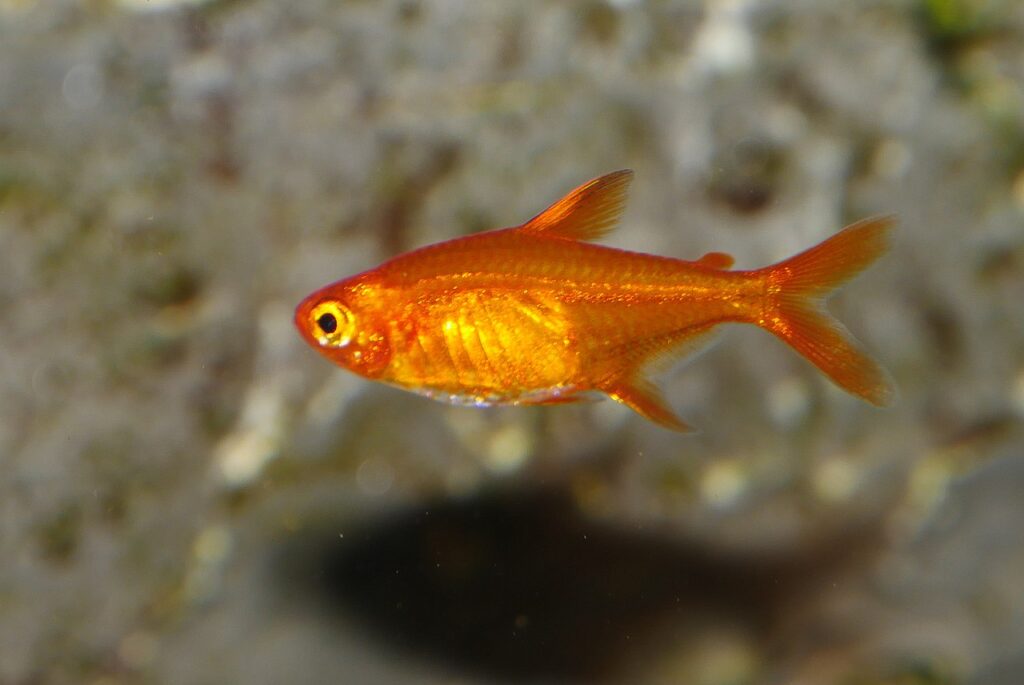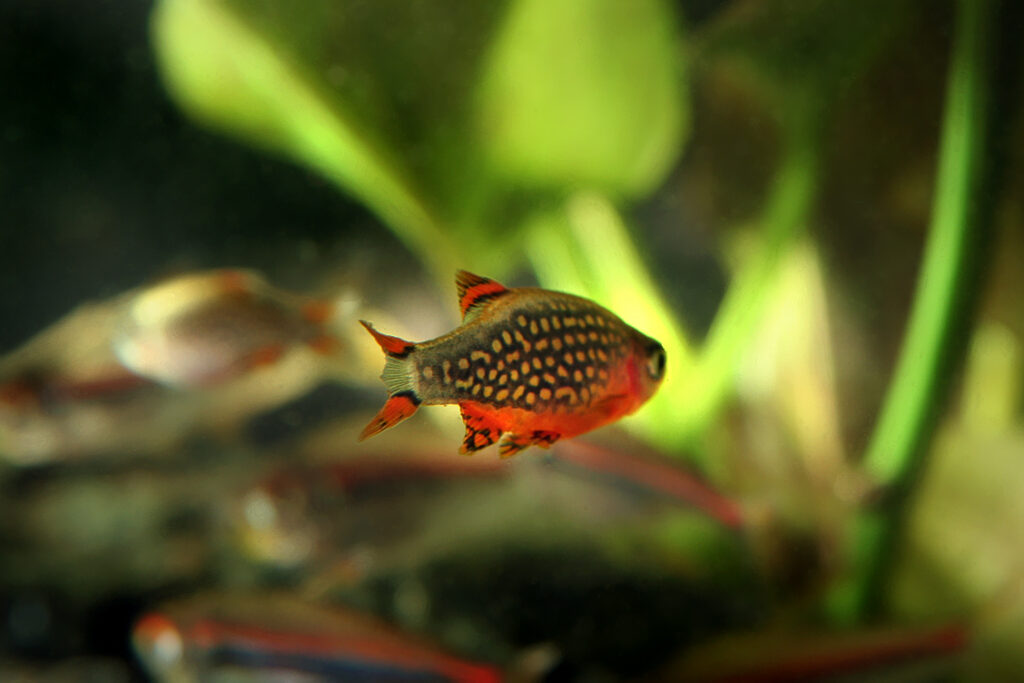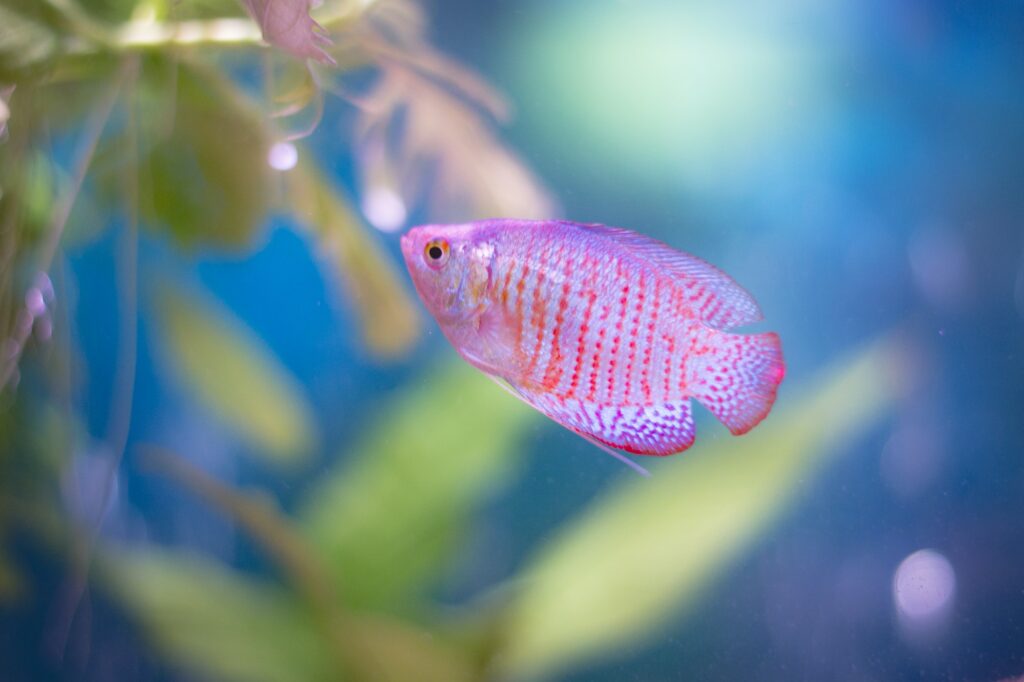In the captivating world of aquariums, the Lambchop Rasbora (Trigonostigma espei) has earned its place as a beloved resident. This diminutive fish, often referred to as the False Harlequin or Narrow Wedge Harlequin, belongs to the Cyprinidae family, sharing its lineage with other popular aquarium species like the Harlequin Rasbora and the Glowlight Rasbora.
Table of Contents
With its striking appearance and peaceful temperament, the Lambchop Rasbora has captured the hearts of aquarists worldwide. Native to the slow-moving streams and rivers of Southeast Asia, particularly in Thailand, Malaysia, and Indonesia, this species thrives in heavily planted habitats with gentle currents.
One of the most intriguing aspects of the Lambchop Rasbora is its unique coloration. The body is adorned with a deep, coppery-red hue, complemented by a distinct black triangular patch on its side, resembling a lambchop – hence its common name. This eye-catching pattern makes it a standout addition to any well-planted community tank.
Lambchop Rasboras are known for their peaceful and social nature, making them an ideal choice for community aquariums. They prefer the company of their own kind and should be kept in schools of at least six individuals to ensure their well-being and natural behavior. When housed together, these fish showcase their playful side, engaging in lively interactions and adding a dynamic element to the aquarium.
In terms of care, the Lambchop Rasbora is a relatively low-maintenance species. As mid-level dwellers, they inhabit the middle and upper regions of the tank, occasionally darting to the surface to catch small insects or food particles. A well-planted aquarium with a variety of vegetation, including floating plants, provides them with ample hiding spots and a sense of security.
When it comes to diet, Lambchop Rasboras are omnivorous and adaptable. They readily accept a wide range of foods, including high-quality flake or pellet foods, as well as frozen or live options such as brine shrimp, daphnia, and bloodworms. Offering a varied diet ensures they receive the necessary nutrients for optimal health and vibrant coloration.
Interestingly, the Lambchop Rasbora has a rich history in the aquarium trade. First described by the renowned ichthyologist Maurice Kottelat in 1991, this species quickly gained popularity among hobbyists for its striking appearance and peaceful demeanor. Today, it remains a sought-after addition to planted community tanks worldwide.
Fun fact: Did you know that the Lambchop Rasbora is known to exhibit a unique behavior called “playing dead”? When frightened or stressed, these fish may suddenly stop moving and lay motionless on the substrate, only to spring back to life moments later – a fascinating quirk that adds to their charm!

Key Information
The Lambchop Rasbora (Trigonostigma espei) is a stunning freshwater fish that captivates aquarists with its unique coloration. The body of this rasbora species is predominantly a rich, coppery-red hue, which serves as a striking backdrop for the distinctive black triangular patch on its side. This dark marking, resembling a lambchop, is what gives the fish its common name. The contrast between the vibrant red and deep black creates a visually appealing and eye-catching appearance, making the Lambchop Rasbora a standout addition to any well-planted aquarium.
| Family | Cyprinidae |
| Origin | Southeast Asia (Thailand, Malaysia, Indonesia) |
| Price | Affordable |
| Common Names | Lambchop Rasbora, False Harlequin, Narrow Wedge Harlequin |
| Variants | None known |
| Ideal Tank Size | 20 gallons or larger |
| Water Parameters | Temperature: 73-79°F (23-26°C), pH: 6.0-7.5, Hardness: 2-15 dGH |
| Lifespan | 3-5 years |
| Full Size | 1.2-1.5 inches (3-4 cm) |
| Natural Environment | Slow-moving streams and rivers with heavy vegetation |
| Behavior | Peaceful, schooling fish |
| Habitat Preference | Mid-level dweller, prefers heavily planted tanks |
| Aquarium Decoration | Plenty of vegetation, including floating plants, driftwood, and rocks |
| Ideal Tank Mates | Other peaceful, similarly-sized fish (e.g., Tetras, Danios, Corydoras) |
| Fish to Avoid | Large, aggressive fish that may view them as prey |
| Best Foods/Diet | Omnivorous; accepts high-quality flake or pellet foods, frozen or live foods (brine shrimp, daphnia, bloodworms) |
| Disease | Susceptible to common freshwater diseases if water quality is poor |
| Sex-Switch | No sex-switching behavior observed |
| Gender Differences | Males may be slightly more slender and colorful than females |
| Care Level | Easy |
| Breeding Level | Moderate; egg-scatterers that require specific conditions for successful breeding |
Ideal Tank Mates
When choosing tank mates for Lambchop Rasboras (Trigonostigma espei), it’s essential to consider their peaceful nature, size, and habitat preferences. These fish thrive in a well-planted aquarium with plenty of hiding spots and gentle water flow. Ideal tank mates should have a similar temperament, size, and environmental requirements to ensure a harmonious and stress-free community.
Lambchop Rasboras are schooling fish that prefer the company of their own kind, so it’s best to keep them in groups of at least six individuals. This not only promotes their natural behavior but also helps them feel more secure and confident in the aquarium.
When selecting tank mates, look for species that are peaceful, similarly sized, and have a compatible activity level. Avoid larger, aggressive fish that may view the Lambchop Rasboras as prey or outcompete them for food. Here are 15 ideal tank mates for Lambchop Rasboras, along with explanations of why they are compatible:
1. Harlequin Rasbora (Trigonostigma heteromorpha)

Harlequin Rasboras are close relatives of Lambchop Rasboras and share similar requirements. They are peaceful, active, and have a striking appearance that complements the Lambchops.
2. Neon Tetra (Paracheirodon innesi)

Neon Tetras are small, colorful, and peaceful fish that make excellent tank mates for Lambchop Rasboras. They occupy the mid-level of the aquarium and have similar water parameter requirements.
3. Cardinal Tetra (Paracheirodon axelrodi)

Like Neon Tetras, Cardinal Tetras are small, vibrant, and peaceful schooling fish that can coexist harmoniously with Lambchop Rasboras.
4. Ember Tetra (Hyphessobrycon amandae)

Ember Tetras are tiny, red-orange fish that add a splash of color to the aquarium. They are peaceful and have a similar activity level to Lambchop Rasboras.
5. Rummy Nose Tetra (Hemigrammus rhodostomus)

Rummy Nose Tetras are peaceful, active swimmers that thrive in schools. They have a unique appearance with their bright red noses and are compatible with Lambchop Rasboras.
6. Cherry Barb (Puntius titteya)

Cherry Barbs are small, colorful, and peaceful fish that make great tank mates for Lambchop Rasboras. They prefer similar water conditions and are active swimmers.
7. Celestial Pearl Danio (Danio margaritatus)

Celestial Pearl Danios, also known as Galaxy Rasboras, are small, peaceful, and stunningly patterned fish. They occupy the mid-level of the aquarium and have similar requirements to Lambchop Rasboras.
8. Chili Rasbora (Boraras brigittae)

Chili Rasboras are tiny, red-colored fish that are peaceful and active. They make excellent tank mates for Lambchop Rasboras due to their similar size and temperament.
9. Pygmy Corydoras (Corydoras pygmaeus)

Pygmy Corydoras are small, peaceful bottom-dwellers that help keep the substrate clean. They are compatible with Lambchop Rasboras and add diversity to the aquarium.
10. Otocinclus Catfish (Otocinclus spp.)

Otocinclus Catfish are small, peaceful algae eaters that help maintain a clean aquarium. They are compatible with Lambchop Rasboras and occupy the lower levels of the tank.
11. Dwarf Gourami (Trichogaster lalius)

Dwarf Gouramis are peaceful, colorful fish that occupy the top and mid-levels of the aquarium. They have a mild temperament and can coexist with Lambchop Rasboras.
12. Endler’s Livebearer (Poecilia wingei)

Endler’s Livebearers are small, colorful, and peaceful fish that make great tank mates for Lambchop Rasboras. They have similar water requirements and are active swimmers.
13. Kuhli Loach (Pangio kuhlii)

Kuhli Loaches are peaceful, eel-like fish that occupy the bottom of the aquarium. They are nocturnal and help keep the substrate clean, making them compatible with Lambchop Rasboras.
14. Sparkling Gourami (Trichopsis pumila)
Sparkling Gouramis are small, peaceful labyrinth fish that have a shimmering appearance. They prefer similar water conditions to Lambchop Rasboras and occupy the mid and top levels of the aquarium.
15. White Cloud Mountain Minnow (Tanichthys albonubes)

White Cloud Mountain Minnows are small, hardy, and peaceful fish that thrive in schools. They have similar water requirements to Lambchop Rasboras and make excellent tank mates.
FAQs
How many Lambchop Rasboras should I keep in my aquarium?
Lambchop Rasboras are schooling fish and should be kept in groups of at least six individuals. Keeping them in larger numbers helps reduce stress and promotes their natural schooling behavior, which is essential for their overall well-being.
Can Lambchop Rasboras be kept with shrimp?
Yes, Lambchop Rasboras are generally peaceful and can be kept with shrimp, such as Cherry Shrimp or Amano Shrimp. However, it’s essential to provide plenty of hiding spots for the shrimp, especially if you have a larger school of Lambchop Rasboras.
Are Lambchop Rasboras sensitive to water changes?
Like most fish, Lambchop Rasboras can be sensitive to sudden changes in water parameters. It’s crucial to perform regular water changes, but make sure to do so gradually to avoid stressing your fish. Aim for a 10-15% water change every week or a 20-30% change every two weeks.
How often should I feed my Lambchop Rasboras?
Feed your Lambchop Rasboras small amounts of food 2-3 times a day. Offer a variety of high-quality flake or pellet foods, along with occasional treats of frozen or live foods like brine shrimp or daphnia. Be careful not to overfeed, as this can lead to poor water quality and health issues.
Can Lambchop Rasboras be kept in a planted tank?
Absolutely! Lambchop Rasboras are an excellent choice for planted aquariums. They appreciate the natural cover and hiding spots provided by aquatic plants and tend to display their best coloration and behavior in a well-planted environment.
How can I tell the difference between male and female Lambchop Rasboras?
Distinguishing between male and female Lambchop Rasboras can be challenging, as they do not exhibit striking sexual dimorphism. However, males may be slightly more slender and colorful than females, particularly during breeding periods.
Do Lambchop Rasboras jump out of the aquarium?
While it’s not a common occurrence, Lambchop Rasboras may jump out of the aquarium if they feel stressed or if the water quality is poor. To prevent this, make sure to keep your aquarium covered and maintain stable water parameters.
Can I keep Lambchop Rasboras with bettas?
It’s generally not recommended to keep Lambchop Rasboras with bettas. Bettas can be aggressive and territorial, which may stress out the peaceful Lambchop Rasboras. It’s best to house bettas separately or with other compatible species.
How long do Lambchop Rasboras typically live?
With proper care and a well-maintained aquarium, Lambchop Rasboras can live between 3-5 years. Providing them with a healthy diet, good water quality, and a stress-free environment will help ensure they reach their full lifespan.
Can Lambchop Rasboras be bred in captivity?
Yes, Lambchop Rasboras can be bred in captivity, but it may require some patience and specific conditions. They are egg-scatterers and prefer heavily planted tanks with slightly acidic and soft water for breeding. Providing a high-quality diet and suitable spawning sites, such as java moss or spawning mops, can encourage breeding behavior.